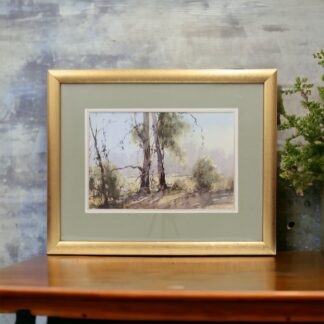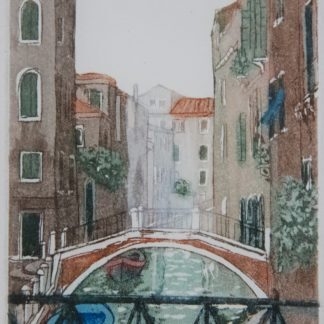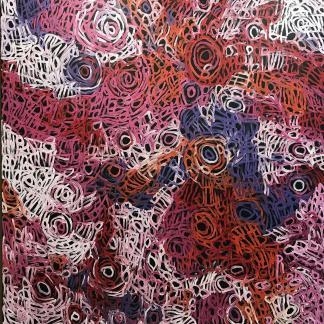Bio & Information
Ningura Naparrula (Australian Aboriginal 1938 – 2013) Bio
Ningura Naparrula was born in 1938 near Kiwirrkura community in the Gibson Desert 700 km west of Alice Springs. Naparrula and her husband Yala Yala Gibbs Tjungurrayi walked to Papunya with their whole family group as part of a general migration of Pintupi people from their country due to drought
Her husband Yala Yala Gibbs was a highly respected Pintupi elder who held significant knowledge of his countries and Dreaming stories he became a founding member of the Papunya Tula artists group, As a young woman Naparrula helped him on the infilling the backgrounds (dotting)on his Tingari Paintings. In 1995 she began painting in her own right in Kintore Women’s Painting Project. It was there that she developed her signature style of diachrome patterns, with occasional use of colour. She formally joined the Papunya Tula company in 1996. Napurrula, along with other women artists, revitalised the company with their work, after the death of many of the male artists in the preceding years.
After her husband’s death in 1998, the volume of paintings she produced increased. Her style is reminiscent of some of Tjungurrayi’s work, but her subject, women’s lives and experiences and their role in mythology, differs. Comparisons have been drawn between her work and that of other Papunya Tula artists, such as Makinti Napanangka and Inyuwa Nampitjinpa. Her status not just as an artist, but as a guardian of cultural heritage meant she was highly regarded in her community and beyond in her lifetime. The palette she used and the way the paint is layered on the canvas is seen as reminiscent of how body paint using their fingers is used by women in ceremonial activities and the tradition of women of the desert sketching symbols for ancestors, places, travelling lines, and animal and human tracks in the sand. Characteristic of her work is a strong dynamism and rich linear design-compositions created with heavy layers of Acrylic paint. Early works examined a range of subjects, but later in her career much of Napurrula’s work focussed on the Rockhole site of Wirrulnga, which was strongly associated with birth and women’s lives.
Napurrula’s work was exhibited in several group shows in 1999 in Sydney, Melbourne, and Darwin. Her first solo exhibition was at William Mora Aboriginal Art in 2000. In 2015 her work featured in a joint exhibition in Singapore, alongside the work of Nanyuma Napagati. Her work has been exhibited in dozens of other exhibitions. In 2002, her work reached national prominence when it featured on an Australian postage stamp. In 2006 Napurrula with three other female and four male artists were commissioned by the Musée du Quai Branly in Paris to produce new works for its ceilings and roof. She saw this as the pinnacle of her career. Napurrual created a huge design on the first-floor ceilings of the museum, based on the work Wirrulnga in the collection at the National Gallery of New South Wales
During her lifetime, Napurrula donated works to set-up and support the Western Desert Dialysis program. The program made dialysis available to remote communities through a purple lorry, which travelled between them; Napurrula’s work featured on one side of it. At the end of her life, she benefited from the treatment the program she had supported could provide
Napurrula’s work is highly collectable and in 2007 and 2008 she was voted one of Australia’s most collectable artists by Australian Art Collector Magazine. Napurrula’s works are held in many prestigious private, national, and international collections, a selection of which are listed below. including the Art Gallery of New South Wales, where several works are part of the larger suite Tjukurrpa Palurukutu, Kutjupawana Palyantjanya, same stories, a new way. Other collections include: National Gallery of Australia Canberra, National Gallery Victoria, Queensland National Art gallery, Museum & Art gallery Northern territory, Alice Springs Art price Collection, Australia Tourism Collection, Australian Broadcasting Corporation Collection, Australian Institute for Aboriginal a Torres Strait Islander Studies Collection Canberra, Architecture Australia Magazine, Aborigena at the palazzo Bricherasio Turin Italy, Australia contemporary Aboriginal Art Prague Czech Republic, Masterpieces from the Western Desert Gavin Graham Gallery London UK, Hood Museum of Art Hanover, National Museum of Women in the Arts Washington USA, The palace of Japan Tokyo, The Harold Mitchell Foundation and the Australian Council, Art Bank Sydney, Homes a Court Collection Perth, Art gallery of Western Australia, Kelton Foundation USA, Donald Kahn Collection, Heidi Museum of Modern Art Melbourne.
Naparrula paintings depict mythological events of her female ancestors, Her art works focuses on the travels of her female ancestors, the sacred sites that they passed and the mythological significance of the bush tucker that they collected. In mythological times, one old woman, Kutunga Napanangka, passed through this site during her travels towards the east. She passed through numerous sites along the way before arriving at the permanent water site of Muruntji south west of Mt Leibig. These travels and rituals help explain the current customs and ceremonial lives of these Desert Pintupi women. The designs in her paintings are associated with the Rockhole sites of Palturunya and Wirrulnga, east of the Kiwirrkura Community (Mt. Webb) in Western Australia. The concentric circles represent Rockhole’s, and the arcs represent rock outcrops near the site. The lines coming from the Rockhole’s represent water. The U shapes represent women camped at the site















